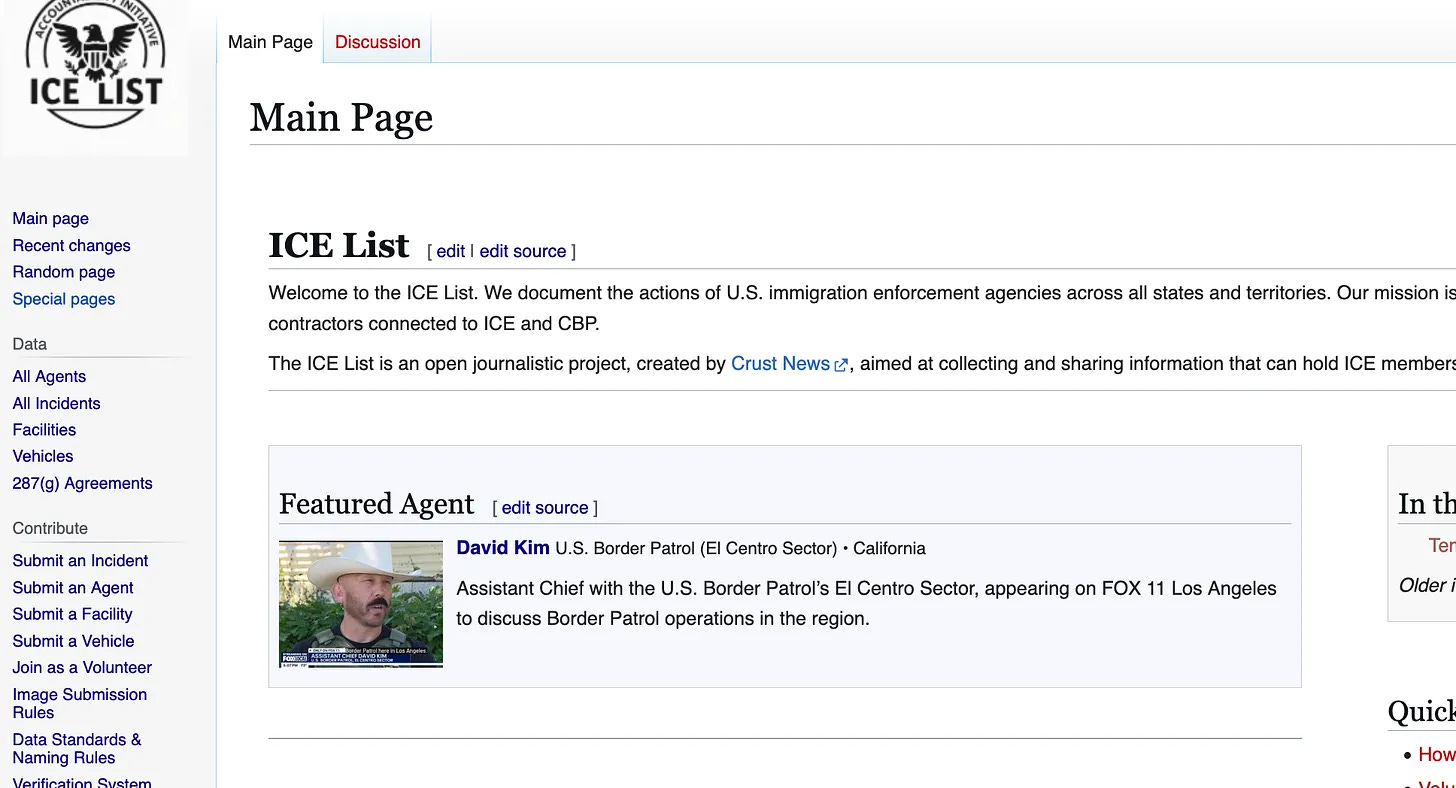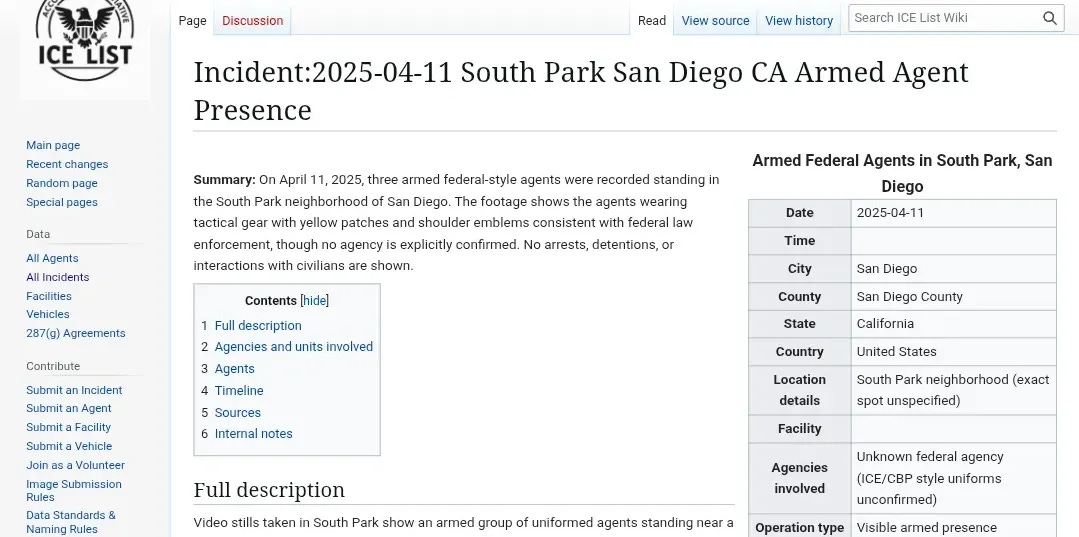NEWS: ICE List Launches Wiki to Expose Enforcement Network
The Europe-based volunteer-built database links raids, agents, vehicles, and legal structures, aiming to break the cycle of official secrecy.
WASHINGTON — Immigration accountability advocates today unveiled a sweeping new online “Wiki” built on the ICE List project, promising, for the first time, a central, searchable record tying individual immigration agents to raids, vehicles, local police partners, and the legal machinery behind U.S. immigration enforcement.
A new hub for a hidden system
The new Wiki is designed to function like a dedicated Wikipedia for Immigration and Customs Enforcement, transforming what organizers describe as “thousands of small, quiet actions” into a single, connected public record.
According to organizers, each ICE raid, roadside stop, courthouse grab, or home visit will get its own page, linking out to the agents who took part, the field offices involved, the contractors paid, and even the cars that showed up on the block.
In the words of the project’s creators, it is a response to a basic democratic failure: in a system that routinely tears families apart, there is still “no consistent paper trail, no central record, no way to trace who was involved or how often it happens.”
MIGRANT INSIDER is sponsored by

From list of agents to full enforcement map
Originally known for publishing the names and photos of ICE agents, the ICE List team says the past six months brought in a “mountain of data” that made the old format unworkable.
What began as an effort to identify individual officers has evolved into a far more ambitious accountability tool. Soon, organizers say, every incident will be mapped to who was there, which ICE facility or federal agency they came from, what vehicle they used, who led the team, and how many times they’ve appeared in other operations.
The homepage of the new Wiki will spotlight one agent each day, foregrounding patterns of conduct that would otherwise remain scattered and forgettable.
Making denial harder for the regime
The stated goal is blunt: strip away what organizers describe as “plausible deniability” for a ruling regime they call one of the most dangerous in modern U.S. history.
When records are fragmented—buried in FOIA responses, siloed in local police logs, or never written down at all—supporters of hardline enforcement can insist that abuses are isolated or unproven.
By tying every incident to agents, counties, agreements, and contractors, the Wiki aims to make systemic abuse visible in one place. “When the information isn’t centralised, accountability becomes impossible,” the team argues. “If the record doesn’t exist, make one.”
MIGRANT INSIDER is sponsored by:
Built for volunteers, protecting anonymity
Behind the launch is a sprawling volunteer operation that has outgrown its original tools. Organizers say they had long planned a more robust internal system, driven by the twin pressures of processing enormous volumes of tips and protecting the anonymity of those doing the work.
The Wiki framework, they concluded, offered a way to absorb and structure more than 1,700 reported agent identities and a growing backlog of incident reports, while still shielding contributors from retaliation. Before the public rollout, a test version will go live for volunteers; until then, agent information will continue to be posted on the existing ICE List site.
Tracking the cars, not just the badges
In a nod to the way communities actually experience raids, the Wiki will give vehicles their own pages.
Organizers say anyone watching closely has learned that SUVs and vans are often the first clue: the same model and markings appearing in different states, sometimes with a rotation of license plates.
Under the new system, each sighting can be logged and linked, allowing residents, lawyers, and journalists to follow the movement of specific vehicles across time and geography. In practice, it means that even when agents hide their faces, the cars they rely on can still betray a pattern.
Exposing local police and 287(g) partners
The project explicitly rejects the fiction that ICE operates alone. The Wiki will profile local police departments and sheriffs’ offices that assist in raids, whether through formal 287(g) agreements that deputize local officers as immigration agents or more informal on-the-ground cooperation.
Some departments, the organizers note, assist even when state leaders or police brass have tried to distance themselves from ICE tactics. The aim is to make that collaboration impossible to quietly maintain: “American citizens deserve to know what law enforcement offices stand with them, and which ones stand with Trump,” the announcement declares.
An archive of how raids are covered
Beyond raw enforcement data, the Wiki will double as a media archive. The team plans to catalogue every news story mentioning ICE—“from the smallest local outlet to the national pieces”—sorted by date and state, and then filed under the relevant incident pages.
That structure will let readers see, raid by raid, how different outlets framed the same operation, what details they omitted, and whether follow-up reporting ever materialized. The hope is that this parallel record will help communities judge which newsrooms can be trusted to cover immigration enforcement with rigor and which are content to repeat official narratives.
Demystifying the law that enables it
A separate section of the Wiki will walk users through the legal scaffolding behind modern immigration enforcement: the programs ICE leans on, the loopholes it exploits, and the obligations it routinely ignores.
Organizers say this legal explainer will be written in plain language, deliberately countering the dense, opaque jargon that keeps many families from understanding what is happening to them.
By laying out the “architecture of enforcement” in accessible terms, the project aims to shift some measure of power back to voters, residents, and those directly targeted by raids.
Part of a wider digital resistance
The ICE List team stresses that this Wiki is not about building a heroic brand, but about doing work that has become unavoidable in 2025.
They cast the project as one node in a broader ecosystem of “digital resistance” to what they call a dangerous regime: a landscape that includes alert networks such as StopICE.net and a wave of local and national efforts to track federal enforcement in real time.
In that sense, the Wiki is both a database and an indictment—a living record built because, as the organizers put it, “the information simply wasn’t being collected anywhere else.”
A promise “until it’s no longer necessary”
For now, the team is clear-eyed about the scale of the task: backlogs to clear, software to harden, volunteers to train, and a hostile government already moving to shut down projects like theirs.
But they also frame the work as a promise, not a stunt. As long as raids continue in secrecy and families are taken with no public ledger of who ordered or carried out the operation, they say, the Wiki will keep expanding.
“The simple fact is,” the announcement concludes, “we’re making a Wiki of ICE data, because it has become necessary. We will continue to do the work we see as necessary, until it no longer is.”
If you’ve read this far, you understand why news like this matters. Subscribe or donate to help Migrant Insider grow.









This is brilliant. Thank you to the people organizing this!
Yes, these records will be very important in the future to identify and prosecute ICE, CBP, and local police participating in these violent, illegal detentions.